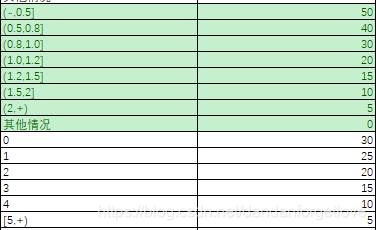需求背景:
进行分值计算。如下图,如果只是一两个还好说,写写判断,但是如果有几十个,几百个,会不会惨不忍睹。而且,下面的还是三种情况。
例如:


解决:
# 根据值、比较list, 值list,返回区间值, other_value 即不在的情况
def get_value_by_between(self, compare_value, compare_list, value_list, other_value, type="compare", left=False,
right=True):
try:
if compare_value is None or compare_value == '':
return other_value
if len(compare_list) != len(value_list):
raise Exception("区间对比两个list长度不一致")
# # 如果比较的值和其它情况值一致,说明是其它情况
# if compare_value == other_value:
# return other_value
# 左边开区间
if compare_list[0] == -9999999 and compare_list[1] >= compare_value:
return value_list[0]
# 右边开区间
if right is True and compare_value > compare_list[len(compare_list) - 1]:
return value_list[len(compare_list) - 1]
# 左边开区间
# if left is True and compare_value <= compare_list[0]:
# return compare_value[0]
for ind, this_val in enumerate(compare_list):
# 如果是最后一个,则返回最后一个值
if compare_value > compare_list[len(compare_list) - 1]:
return value_list[len(compare_list) - 1]
# 返回默认的
elif (ind + 1) == len(compare_list):
return other_value
# 下一个,如果大于compare_list长度减1 ,就返回最后一个
next_val = compare_list[ind if ind >= len(compare_list) else ind + 1]
# 第一个的话就是 大于等于,小于下一个
if ind == 0 and compare_value >= this_val and compare_value <= next_val:
return value_list[ind]
# 大于左边,小于等于右边
elif this_val < compare_value and compare_value <= next_val:
return value_list[ind]
except:
log.error("根据区间计算分数异常", traceback.format_exc())
return other_value
# 数字型
def get_val_by_list(self, compare_value, compare_list, val_list, other_value):
try:
if compare_value is None:
return other_value
for ind, li in enumerate(compare_list):
if len(li) == 1 and compare_value == li[0]:
return val_list[ind]
# 最后一个
elif len(li) == 1 and (ind + 1) == len(compare_list) and compare_value >= li[0]:
return val_list[ind]
elif len(li) == 2 and compare_value >= li[0] and compare_value <= li[1]:
return val_list[ind]
except:
log.error(" get_val_by_list 异常", traceback.format_exc())
return other_value
TEST
# creditTime 即值
self.get_val_by_list(creditTime, [[0],[1],[2],[3]], [20, 10, 0, -100],
other_value=0)
self.get_value_by_between(taxCreditRating, [0, 60, 70, 80, 90],[-200, 0, 10, 20, 30], other_value=0)
如果是图2,即第三种情况,则需要多加一个0,和对应的值。
self.get_value_by_between(taxAmt12m, [0,0, 1000, 15000, 50000, 200000],[-50, -50, 0, 0, 5, 10], -0)
如果是负无穷大,则使用-999999
jsjbwy



